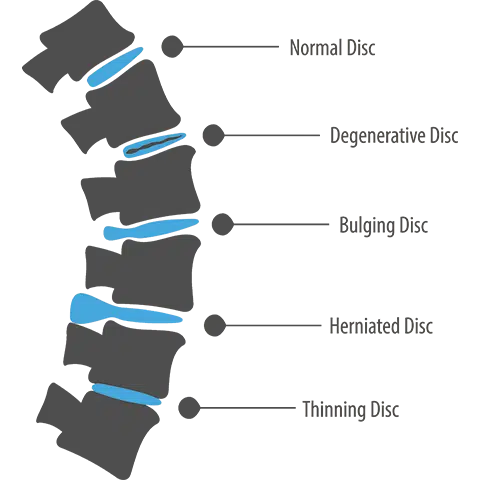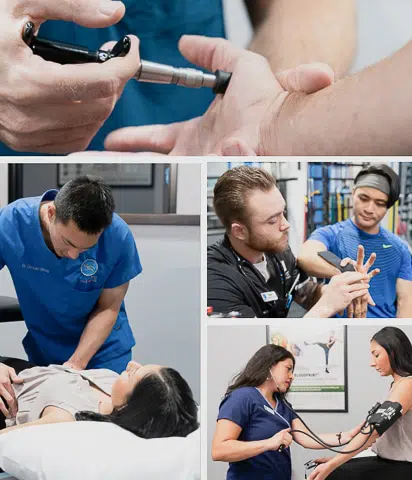Bulging + Herniated Disc

Appointment Inquiries
Call us at: (877) 222-5348
Definition
A bulging disc occurs when the inner layer of a spinal disc protrudes toward the outer layer.A herniated disc occurs when the outer layer of a spinal disc protrudes outside of the exterior of the disc itself.
Root Causes
"Pins and Needles", Arm Pain, Back Pain, Foot Pain, Injury, Leg Pain, Myofascial Pain Syndrome, Numbness + Tingling, Overactive Reflexes, Sciatica, Spinal Stenosis, Stiff Neck, Weakness
Risk Factors
Family History, Obesity, Physically Demanding Work, Smoking
Treatments
Chiropractic, Massage Therapy, Medical Intervention, Physical Therapy, Spinal Decompression
What is a bulging disc?
Your spinal discs or intervertebral discs are fibrous, gel-filled shock absorbers that provide cushion between your vertebrae (“back bones”). These discs are what allow your spine to bend and move without pain. A bulging disc is when one or more of your spinal discs are misaligned or protruding from where they should be.
Bulging and herniated discs can compress your spinal discs, weakening their outer lining and making them bulge out of place. Healthy discs’ edges should sit in line with the vertebrae both above and below to provide the right cushion.
A bulging disc is usually caused by sudden injury like a car accident or any unexpected load, but it can also be caused by long-term poor posture, genetic factors, and some cases of scoliosis. A building disc is most common in the lower back, but you can experience a bulging disc anywhere in your back and into your neck.
A bulging disc, sometimes called a protruding disc or slipped disc, can be excruciatingly painful, or you may experience no pain. But if left untreated, it can progress to the more painful herniated disc.
OK, so what’s a herniated disc?
A herniated disc, sometimes called a ruptured disc, happens when the fibrous disc cover cracks open. This allows some of the inner jelly-like substance to slip out and press harder on your spinal cord within the spinal canal. Herniated discs are often much more painful than a bulging disc.
A herniated disc also suggests that a disc is in the early stages of degeneration. If left untreated, degenerative disc disorder can develop and often requires invasive surgery.
How do I know if I have bulging disc or herniated disc?
Symptoms of these disc issues include:
- Arm, leg, or foot pain or numbness
- Back pain
- Muscle weakness or spasms
- Overactive reflexes
- “Pins and needles” or tingling/burning sensation
- Stiff neck
A lumbar herniated disc may also contribute to or cause sciatica, painful pressure on your sciatic nerve in your lower back and upper leg.
How do you diagnose and treat bulging, herniated, and degenerative disc?
If you’re experiencing one or more of these symptoms, we highly recommend that you seek diagnosis. Not every disc requires intervention. However, we strongly advise that you get ahead of a potential problem with a diagnosis. If caught early, you can avoid future issues.
One of the primary ways that bulging, herniated, and degenerative disc disease is found is imaging. Here at BackFit Health + Spine, we offer comprehensive evaluations and on-site x-rays specifically for issues like this.
If we do diagnose a disc problem, one or more of the following treatment options can help:
- Regular chiropractic: by keeping the alignment of your spine correct, the discs will come in line, relieving pressure on pinched nerves.
- Spinal decompression: this non-surgical option of targeted traction gently reshapes the discs to provide internal healing.
- Physical therapy: incorporating PT strengthens and retrains your musculature to maintain good posture and prevent future disc injury.
- Massage therapy: massage can relieve pain from muscle spasms and recondition the spine to support itself through the soft tissue.
- Medical care: if the pain is persistence or intense, our medical team can provide immediate pain relief options to improve you higher quality of life while we assist you in healing the underlying condition.
More About BackFit
Looking to learn more? Explore our locations, treatments, or our new patient offer below or contact one of the BackFit Family of staff to have your questions answered.


